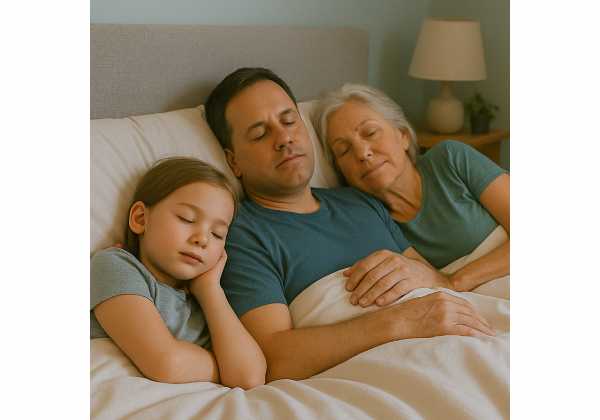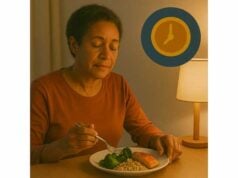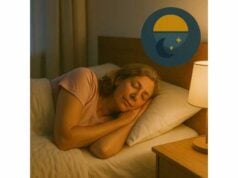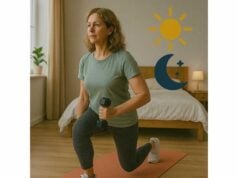
Sleep changes as we age, but the goal stays the same: steady energy, clear thinking, and recovery that supports a long, healthy life. This guide translates research into age-specific steps you can actually do—what to change in your 30s and 40s, how to navigate hormones and weight in your 50s, and what to prioritize in your 60s and beyond. You will find the few metrics that matter, what to raise at annual checkups, when to request a sleep evaluation, and how to upgrade your bedroom without buying gimmicks. Each checklist is brief on purpose; use it once a year to course-correct. If you want a broader framework for managing stress and recovery alongside sleep, visit our pillar on evidence-based sleep and stress habits.
Table of Contents
- Your 30s and 40s: Building Durable Sleep Habits
- Your 50s: Hormonal Changes, Weight, and Snoring Risk
- Your 60s and Beyond: Pain, Medications, and Wake Time Anchors
- Core Metrics to Watch: Sleep Efficiency, Latency, and HRV
- Annual Checkups and When to Request a Sleep Evaluation
- Bedroom Environment and Routine Upgrades by Age
- A One Page Sleep Checklist You Can Revisit Each Year
Your 30s and 40s: Building Durable Sleep Habits
Your 30s and 40s are about consistency under pressure—careers, caregiving, and screens that never stop. The most durable habits are simple, repeatable, and tolerant of busy weeks.
Timing anchors that carry you for decades
- Wake window: Fix a 7-day wake time within ±30–60 minutes. This single anchor pulls bedtime into line and shrinks social jet lag.
- Light: Get 10–20 minutes of outdoor light within an hour of waking. At night, dim lights 90 minutes before bed; move bright tasks earlier.
- Caffeine cut-off: Stop 8–10 hours before lights-out. If you have a rare late night, keep caffeine front-loaded the next day; do not “revenge dose” late.
Training and timing
- Exercise most days, but place vigorous sessions earlier when possible. Late high-intensity training can delay sleep; if evenings are your only option, finish 2–3 hours before bed and add a short wind-down (shower, reading, breathing).
- If fat loss or metabolic health is a priority, align larger meals earlier and keep dinner 3–4 hours before sleep. Small changes (earlier dinner by 30–60 minutes) pay off.
Wind-down that works
- Pick a 15–30 minute routine you actually enjoy: a warm shower, brief stretches, and 4–7–8 breathing (4-second inhale, 7-second hold, 8-second exhale) for 4–6 cycles.
- Devices: enable night modes, enlarge text, and lower brightness. Park the phone outside the bedroom when you can.
Red flags to tackle now
- Snoring with witnessed pauses, restless legs in the evening, or daytime sleepiness despite 7–8 hours in bed—do not wait. Screening in these decades prevents larger problems later.
- Shift work or frequent travel: Build a “travel sleep kit” (mask, earplugs, soft-shell blackout) and a jet lag plan. Consistency beats hacks.
One change this quarter
- Choose a single lever (earlier dinner, fixed wake time, or morning light) and run it for 3–4 weeks. Track sleep latency and morning alertness; keep what moves the needle.
These habits are not glamorous, but they compound. Strengthen them now and your 50s will be smoother.
Your 50s: Hormonal Changes, Weight, and Snoring Risk
Your 50s often bring hormonal shifts, body composition changes, and subtle airway anatomy changes. The result can be lighter sleep, more awakenings, and snoring that was not present before.
Hormones and temperature regulation
- Women in peri- and postmenopause: Declining estrogen and progesterone can fragment sleep, increase hot flashes, and raise the risk of sleep-disordered breathing. Temperature sensitivity makes cooler bedrooms (16–19 °C / 60–66 °F), breathable bedding, and layered sleepwear practical fixes. Discuss menopausal symptom management with your clinician; addressing vasomotor symptoms often improves sleep quality.
- Men in andropause: Gradual hormonal shifts may affect body fat distribution and snoring risk. Screen for nocturia (nighttime urination), which fragments sleep; timing fluids and checking medications or prostate symptoms can help.
Weight, neck circumference, and airway
- A small weight gain can increase snoring and the chances of obstructive sleep apnea (OSA), especially with a larger neck circumference. If your partner notices pauses, choking, or gasping, treat this as medical, not merely annoying. The fix might be as simple as positional strategies while awaiting evaluation.
Metabolic timing and reflux
- Late, heavy dinners and alcohol close to bedtime drive reflux, which wakes you and reduces deep sleep. Finish dinner 3–4 hours before bed and leave 2–3 hours between alcohol and sleep if you drink at all. If reflux persists, elevate the head of the bed by 10–15 cm (4–6 inches) and discuss evaluation.
Snoring checklist
- Record: a week of partner observations or a smartphone snore log.
- Screen: STOP-BANG or other simple tools can guide next steps.
- Act: If scores or symptoms are high, request a diagnostic study (home or lab) rather than guessing.
Stress and sleep fragility
- Midlife caregiving, finances, and career shifts add pressure. Brief, daily decompression beats occasional marathon resets. Consider a 5-minute box breathing or a short meditation most evenings; these are small but stabilizing.
For a practical overview of hormone-related sleep changes and options to discuss with your clinician, see our concise guide to hormones and sleep in midlife.
Your 60s and Beyond: Pain, Medications, and Wake Time Anchors
In later decades, sleep can become lighter and more fragmented. Some change is normal; the goal is comfort, regularity, and safety. Three themes dominate: pain control, medication review, and strong morning anchors.
Pain and comfort basics
- Chronic pain—arthritic joints, neuropathy, or back pain—often peaks at night. Small adjustments matter: a pillow between the knees for side sleepers, a thin pillow under the calves for back sleepers, and experimenting with mattress topper firmness.
- If you wake with stiffness, a 2–3 minute mobility sequence before bed and on waking can lower pain enough to keep sleep consolidated.
Medication review
- Many older adults take medications that affect sleep: diuretics (nocturia), beta-blockers (may suppress melatonin), stimulants or decongestants, and some antidepressants (activation). At your annual visit, request a sleep-focused medication review: identify agents that cause restlessness or awakenings and ask about safer timing or alternatives.
- Be cautious with over-the-counter antihistamines for sleep; they impair next-day alertness and increase fall risk. If insomnia persists, pursue non-drug options first.
Wake time anchors and light
- Circadian amplitude often diminishes with age, making morning light and a fixed wake time critical. Go outside within an hour of waking for 15–20 minutes, even on cloudy days. Pair with a consistent breakfast time to reinforce the signal.
- If you tend to fall asleep too early and wake at 3–4 a.m., shift evening light later (brighter living spaces, social contact) and a short walk after dinner; trim daytime naps to 20–30 minutes and finish them before mid-afternoon.
Breathing and airway
- Snoring that worsens with age deserves evaluation. Untreated OSA increases risks you want to minimize—hypertension, cognitive change, and arrhythmia. Modern treatments are more comfortable than in the past, including auto-adjusting devices and oral appliances.
Falls and nighttime safety
- Keep clear paths to the bathroom, add night-safe lighting (low, indirect), and consider non-slip socks. If you awaken dizzy, sit for 30–60 seconds on the bedside before standing.
For targeted strategies that ease nighttime discomfort, explore our practical overview of pain, inflammation, and sleep.
Core Metrics to Watch: Sleep Efficiency, Latency, and HRV
Metrics should clarify, not confuse. A handful of signals reliably reflect whether your routines are working across the decades.
Sleep efficiency (SE)
- Definition: minutes asleep ÷ minutes in bed × 100.
- Target: ≥85% most weeks. After schedule changes or travel, expect a temporary dip. If SE stays low, review evening light, caffeine timing, and sleep opportunity (are you in bed far longer than you need?).
Sleep latency
- Goal: ≤20 minutes to fall asleep on most nights. Slow latency points to bright evenings, late meals, anxiety, or an overly early bedtime. Adjust one variable for a week, then reassess.
Wake after sleep onset (WASO)
- Frequent awakenings (>30–45 minutes total) can signal pain, reflux, OSA, or room conditions (noise, temperature). Fix the environment first; if WASO remains high, consider evaluation.
Resting heart rate (RHR) and heart rate variability (HRV)
- RHR: Trends matter more than single nights. A downward drift over months often parallels better fitness and alignment.
- HRV (e.g., RMSSD): Use your baseline range, not population numbers. Look for pattern changes: sustained downturns after late nights or alcohol, rebounds with consistent light timing.
- Use HRV as a decision aid, not a verdict. If you feel great but HRV dips for a night, do not overhaul your plan.
Minimal logging that works
- Each day, note: bedtime, wake time, caffeine cut-off, evening light (dim/bright), exercise timing, and a 1–5 morning alertness score. That small dataset explains most swings.
How to iterate
- Pick one lever (e.g., dim lights 90 minutes before bed).
- Hold for 7–10 days.
- Compare SE, latency, RHR/HRV trend, and how you feel.
- Keep or switch. Then add the next lever.
For deeper context on what HRV can (and cannot) tell you about recovery and aging, skim our primer on HRV and longevity. If device dashboards overwhelm you, our guide to wearables that matter shows how to ignore noise.
Annual Checkups and When to Request a Sleep Evaluation
Make sleep part of routine preventive care. A 10-minute conversation each year can catch treatable problems early.
Bring this to your visit
- Sleep diary snapshot: one representative week with bed/wake times, awakenings, naps, and medications.
- Symptoms list: snoring, witnessed apneas, gasping, morning headaches, restless legs, leg kicks, reflux, nocturia, night sweats, and daytime sleepiness.
- Medication and supplement timing: include caffeine, alcohol, decongestants, antihistamines, and sleep aids.
- Safety notes: drowsy driving, falls, or near misses.
What to request
- Blood pressure seated and standing if you report dizziness on waking.
- A focused review of metabolic labs (fasting glucose or A1c, lipids) if chronic short sleep or OSA is suspected.
- Screening questionnaires: STOP-BANG for OSA, insomnia severity index (ISI), restless legs assessment.
- If symptoms warrant, a diagnostic sleep study (home sleep apnea test or in-lab polysomnography). Choose the modality with your clinician based on symptoms and comorbidities.
When to escalate
- Loud snoring plus witnessed pauses or uncontrolled hypertension—move quickly to testing.
- Chronic insomnia (≥3 nights/week for ≥3 months): ask for cognitive behavioral therapy for insomnia (CBT-I) rather than defaulting to sedating medications.
- Restless legs with irresistible urge to move and evening worsening: request ferritin and iron studies; treat medical drivers first.
Medication caution
- Many over-the-counter sleep aids contain diphenhydramine or doxylamine, which increase confusion and fall risk, especially later in life. If you rely on them, flag this at your visit and ask for safer alternatives and non-drug strategies.
If sleep apnea is on your radar, our brief guide to signs, testing, and treatment basics can help you prepare questions and understand next steps.
Bedroom Environment and Routine Upgrades by Age
You do not need expensive gadgets to build a sleep-friendly space. Start with fundamentals and add age-specific tweaks.
All ages: environment first
- Dark, quiet, cool: blackout shades or a sleep mask; soft, continuous noise (fan or white-noise machine); temperature 16–19 °C (60–66 °F).
- Clutter and cue control: keep the bed for sleep and intimacy; move work devices elsewhere.
- Air quality: if congestion wakes you, trial saline nasal rinses before bed and keep indoor humidity moderate.
30s–40s upgrades
- Screen discipline: enable night modes, move stimulating tasks earlier, and use paper or e-ink for late reading. If evening screens are unavoidable, adopt the habits in our guide to screen hygiene at night.
- Create a fast wind-down: a warm shower, two minutes of mobility, and a short breathwork set so travel or late meetings do not erase your routine.
50s upgrades
- Temperature layering: breathable sheets, a light blanket over a heavier one, and options to remove layers during hot flashes.
- Anti-reflux setup: elevate the head of the bed 10–15 cm (4–6 inches) if heartburn wakes you; avoid late meals.
- Noise fairness: if a partner snores, use comfortable earplugs temporarily, but pursue evaluation rather than adapting forever.
60s and beyond upgrades
- Night navigation: low, indirect night-lights along paths; remove trip hazards; keep water and glasses within easy reach.
- Easy access: chairs with arms near the bed for sit-to-stand support; consider mattress height for safe transfers.
- Medication station: simple organizer with evening vs morning sections to reduce errors.
Routines that stick
- Two anchors: wake time and morning light.
- Two avoidances: heavy late meals and late caffeine.
- Two relaxers: a consistent wind-down and a 1–3 minute gratitude or journaling note to close the day.
For room-by-room tactics, our primer on sleep hygiene basics covers temperature, light, and noise in more detail.
A One Page Sleep Checklist You Can Revisit Each Year
Use this annual checklist as a quick audit. Circle two wins, choose one change, and repeat next year.
Foundations (all ages)
- ☐ Wake time within ±60 minutes seven days a week
- ☐ Morning outdoor light within an hour of waking
- ☐ Caffeine cut-off at least 8 hours before bed
- ☐ Dinner 3–4 hours before bed; minimal alcohol
- ☐ Bedroom dark, quiet, cool (16–19 °C / 60–66 °F)
- ☐ Wind-down 15–30 minutes (shower, stretch, breathwork)
- ☐ In bed 7–9 hours based on your need
30s–40s
- ☐ Night screen plan (night modes, text size, device parking)
- ☐ Exercise most days; if late, finish ≥2–3 hours before bed
- ☐ Plan for travel or shift weeks (mask, earplugs, blackout)
50s
- ☐ Screen for snoring or breathing pauses; consider evaluation
- ☐ Temperature layering for hot flashes or night sweats
- ☐ Reflux plan (earlier dinner, bed elevation if needed)
60s and beyond
- ☐ Annual medication review for sleep effects
- ☐ Night-safe lighting and clear paths to bathroom
- ☐ Short, early naps only (20–30 minutes, before mid-afternoon)
Metrics
- ☐ Sleep efficiency ≥85% most weeks
- ☐ Latency ≤20 minutes on most nights
- ☐ RHR trending down or stable; HRV in your usual range
- ☐ One-line morning alertness score (1–5)
When to seek help
- ☐ Loud snoring with pauses; morning headaches; daytime sleepiness
- ☐ Insomnia ≥3 nights/week for ≥3 months
- ☐ Restless legs or frequent leg kicks disturbing sleep
- ☐ Worsening mood, memory, or blood pressure with poor sleep
Your one change this year
- —
Revisit the checklist every 6–12 months. Keep what works, adjust a single lever, and track results for two weeks before changing again. Small, steady improvements outlast heroic sprints and protect healthspan.
References
- Sleep in Normal Aging (2017) (Review)
- Sleep and Health: A Review of Evidence for the Health Effects of Sleep (2019) (Systematic Review)
- The Impact of Menopause on Sleep: A Review (2020) (Review)
- Obstructive sleep apnea in older adults: A comprehensive review (2023) (Review)
- Wearable Sleep Technology in Clinical and Research Settings (2021) (Review)
Disclaimer
This article provides general education and is not a substitute for personalized medical advice, diagnosis, or treatment. Seek a qualified clinician’s guidance if you have chronic insomnia, suspected sleep apnea, significant daytime sleepiness, new or worsening snoring, frequent nocturia, or if you take medications that may affect sleep. In urgent situations—such as drowsy driving or near falls—stop the activity and get help.
If you found this guide useful, please consider sharing it on Facebook, X (formerly Twitter), or any platform you prefer, and follow us for future articles. Your support helps us continue producing practical, high-quality resources.










